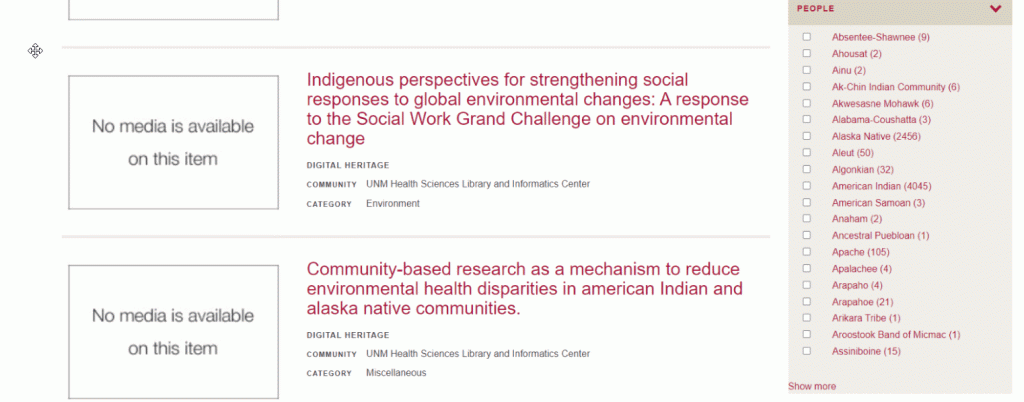
No Comments on A Review of the Native Health Database 295
Deedra J. Walton, MLS, D-AHIP
Head of Electronic Resources
Harriet F. Ginsburg Health Sciences Library
University of Central Florida College of Medicine
The Native Health Database (NHD), created by the University of New Mexico Health Sciences Library and Informatics Center (UNM HSLIC), contains bibliographic information and abstracts of resources about the health and health care of American Indians, Alaska Natives, and Canadian First Nations populations.
Content
The idea for the Native Health Database originated in the early 1990s when the UNM HSLIC received a historical collection of “Papers on Indian Health” from a donor. The collection consisted of over 3,000 documents dating from 1672 to 1966. From 1997 to 2005, UNM HSLIC entered a contractual arrangement with the United States Indian Health Service (IHS) that added an additional 5,000 abstracts to the database. The abstracts describe IHS research and reporting not typically available for public access.
UNM HSLIC director Erika Love and her successor, Holly Buchanan, strongly advocated for the NHD and supported their library team’s involvement in the project. In 2005, Patricia Bradley (Diné), UNM HSLIC’s Native and Distance Services Librarian, assumed formal leadership of the NHD and worked closely with the NHD Advisory Board from 2005 to 2018 on strategic priorities, usability, cultural sensitivity, and issues related to medical research in Native American communities. During her tenure, Bradley added more resources to the NHD, increasing the number of records to over 10,000.
In 2021, after an extensive review of the database led by Jonathan Pringle, HSLIC’s Scholarly Communications and Digital Librarian, UNM HSLIC migrated the NHD to a new platform supported by Mukurtu CMS. Mukurtu, meaning “a safe keeping place,” describes itself as a “free, mobile, and open source platform built with Indigenous communities to manage and share digital cultural heritage.” The platform allows a community of creators rather than a single individual at UNM HSLIC to submit content to the database. The community of creators can submit content using Mukurtu’s customizable, Indigenous-led cultural protocols. The protocols determine the level of access to culturally sensitive resources based on the values and needs of indigenous communities. Some resources may be visible to all users, while others may only be visible to members of a cultural protocol. Protocols may also include Traditional Knowledge (TK) Labels (digital tags) “meant to be used by indigenous communities to provide additional information about cultural heritage materials that are in the public domain or owned by third parties”.
The cultural protocol is listed in the expanded record view of each NHD resource. Clicking on the protocol opens a new webpage listing the members of the protocol, the parent community of the protocol, recent items submitted under the protocol, and a link to request community membership. The NHD does not list the protocols used in the database. However, all the resources explored for this review are part of public access protocols.
Many of the resource types available in the database are journal articles, monographs, reports, and studies. While full-text access may be available directly on the database, most records have a “no media is available on this item” message next to the resource summary. The database does offer external links to the abstract or full text on the expanded resource description page. Access may also be requested from UNM HSLIC using the email at the bottom of the webpage. Requests are filled on a case-by-case basis, and access to some resources may be denied due to copyright or intellectual property rights.
Features/Functionality
Users may access the Native Health Database using its direct link or the Resources menu on the UNM HSLIC home page. The NHD homepage has a menu bar at the top, a welcome statement, and a featured content box. The browse by community options at the bottom of the page allows users to see the content created by the UNM HSLIC or the Indian Health Service.

[Native Health Database Home Page, December 5, 2023, UNM HSLIC]
The menu bar tabs are titled Getting Started, Explore Resources, Related Links, and History. The Getting Started page links to a “How to Access and Use the Native Health Database” tutorial video, offers searching tips, and provides instructions on requesting access to resources and how to create personal collections. The Related Links page links to UNM HSLIC’s Indigenous Health Information in New Mexico research guide and Indian Health Service’s Tribal Epidemiology Center reports. The History page details the beginnings of the NHD and its evolution to the present day. The database itself is accessible on the Explore Resources page. An optional log-in feature is available; however, creating a free account is not required to use the NHD. Only registered users can create public or private personal resource collections and use the downloadable app, Mukurtu Mobile, for syncing and offline access to the NHD.
The database has a basic search box and the search tips recommend a simple search of one or two terms. Multiple search terms are automatically connected by the Boolean operator AND. The NHD uses stemming in place of wildcard searching. Stemming allows the database to understand different word forms of a specific word or query (e.g., flying/fly). Currently, there is no advanced search capability, the ability to use other Boolean operators, nor wildcard searching. However, expanding the use of Boolean operators and wildcard searching is planned for further development.
Each resource in the database has fields of information attached to the record. These fields include protocol, community, category, keywords, the original date of description, original date, creator (author), contributor, language, rights, licensing options, source, external link, publisher, identifier, subject, and type.
An outstanding feature of the NHD is its facet browsing. Facet browsing is a powerful tool that can be used to browse all records in the database or limit search results. Facet menus on the right side of the database allow searching by date created, tribe or people, content creator community, subject, category, and resource type. Beside each facet, in parentheses, is the number of resources in the database for that facet. For example, over three hundred North American Indigenous peoples are listed in the “People” facet.

[Native Health Database Explore Resources web page, December 5, 2023, UNM HSLIC]
MeSH terms are not used throughout the Native Health Database. The subject facet contains unique keywords, dictionary terms, and formal subjects. The category facet is a pre-set list of health-related categories used to organize the resources in the database.
Business Model
The Native Health Database is a free resource made available by the University of New Mexico Health Sciences Library and Informatics Center. The library has received sponsorships and funding support through the years from the New Mexico State Legislature, the National Library of Medicine, the U.S. Indian Health Service, the Center for Public Service Communications, and the NNLM South Central Region.
Breakthrough
The Native Health Database will appeal to health sciences libraries whose users are interested in studying North American Indigenous peoples. This free database provides access to bibliographic information and abstracts of resources about the health and health care of American Indians, Alaska Natives, and Canadian First Nations populations. The information in the database is indexed using facets, and the powerful “People” facet option lets users limit a search to a specific tribal community or people.
References
- Native Health Database. History. https://nativehealthdatabase.net/history. Accessed December 5, 2023
- Mukurtu. https://mukurtu.org/. Accessed December 5, 2023
- Mukurtu. About. https://mukurtu.org/about/. Accessed January 12, 2024
- Mukurtu. Traditional Knowledge Labels FAQ. https://mukurtu.org/support/traditional-knowledge-labels-faq/. Accessed January 12, 2024
- Native Health Database. Get Started. https://nativehealthdatabase.net/about. Accessed December 5, 2023
- How to Access and Use the Native Health Database tutorial video. https://youtu.be/zIPx75iS5lc. Accessed December 5, 2023.


Leave a comment